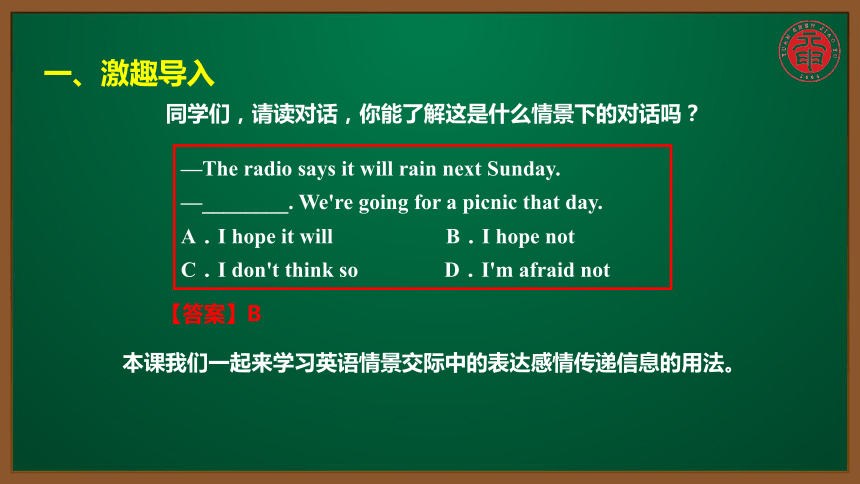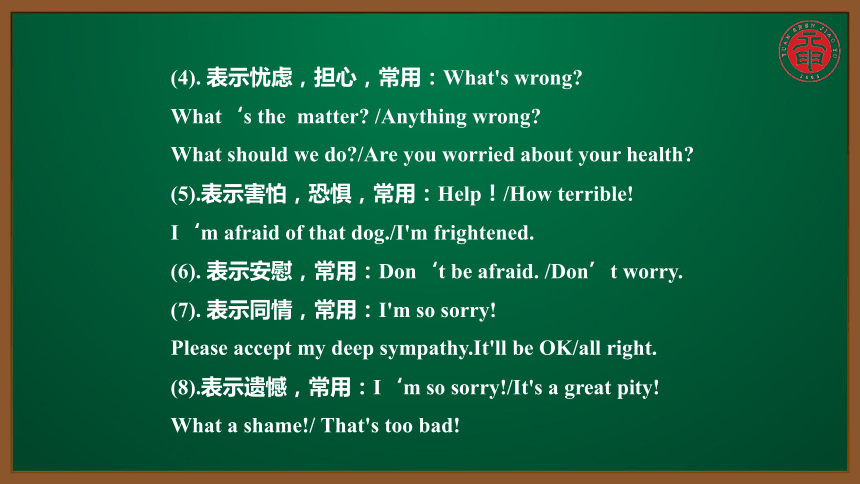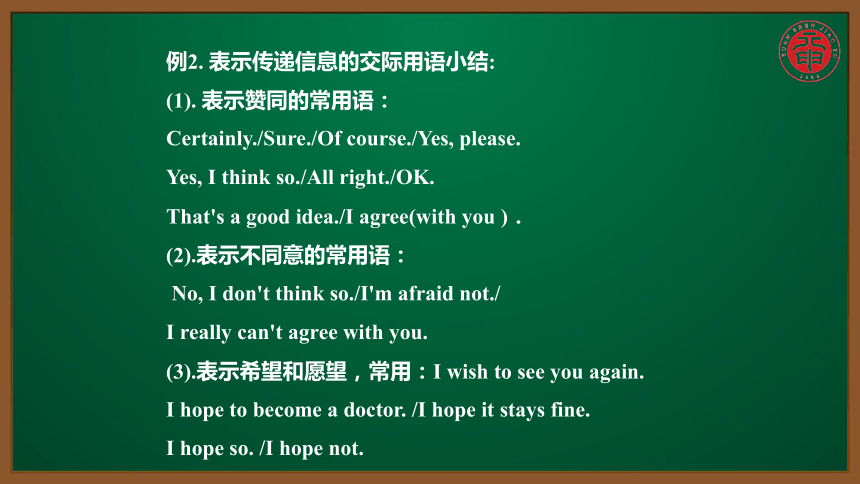初英考点精讲 同课异构 123 表达感情传递信息【知识点微课课件】
文档属性
| 名称 | 初英考点精讲 同课异构 123 表达感情传递信息【知识点微课课件】 |  | |
| 格式 | ppt | ||
| 文件大小 | 440.5KB | ||
| 资源类型 | 试卷 | ||
| 版本资源 | 通用版 | ||
| 科目 | 英语 | ||
| 更新时间 | 2021-07-15 11:33:23 | ||
图片预览






文档简介
表 达 感 情 传 递 信 息
一、激趣导入
同学们,请读对话,你能了解这是什么情景下的对话吗?
—The radio says it will rain next Sunday.
—________. We're going for a picnic that day.
A.I hope it will B.I hope not
C.I don't think so D.I'm afraid not
本课我们一起来学习英语情景交际中的表达感情传递信息的用法。
【答案】B
二、考点剖析
1、命题思路
情景交际是中考英语中每年的必考点,在备考时应掌握好各种常用的情景交际的问答。表达感情传递信息属于情感态度类用语,在考查时注意前后答语及习惯用法。情景交际在汉语中也是很常见,但中英文在思维及表达方式上差距较大,注意用法的不同,同学们在日常学习时也要注意积累常用语句。
例1. 表示情感交际用语。
(1). 表示高兴,常用:How wonderful /nice!
That's lovely /great /wonderful!
I‘m happy. It’s well done. 、I'm pleased to know that.
(2). 表示满意,常用: Good!/Well done!/Perfect!
That's fine./That's better.That's good enough.
I'm pleased with your spoken English.
(3).表示惊讶,常用:Really?/Oh dear!/Is that so?
What a surprise!/How nice to see you!
How surprising!/I'm surprised.
(4). 表示忧虑,担心,常用:What's wrong?
What‘s the matter? /Anything wrong?
What should we do?/Are you worried about your health?
(5).表示害怕,恐惧,常用:Help!/How terrible!
I‘m afraid of that dog./I'm frightened.
(6). 表示安慰,常用:Don‘t be afraid. /Don’t worry.
(7). 表示同情,常用:I'm so sorry!
Please accept my deep sympathy.It'll be OK/all right.
(8).表示遗憾,常用:I‘m so sorry!/It's a great pity!
What a shame!/ That's too bad!
例2. 表示传递信息的交际用语小结:
(1). 表示赞同的常用语:
Certainly./Sure./Of course./Yes, please.
Yes, I think so./All right./OK.
That's a good idea./I agree(with you ).
(2).表示不同意的常用语:
No, I don't think so./I'm afraid not./
I really can't agree with you.
(3).表示希望和愿望,常用:I wish to see you again.
I hope to become a doctor. /I hope it stays fine.
I hope so. /I hope not.
例3.例题分析:
—I hope you don't mind my opening the window.
—________. It's much too hot in here.
A.Certainly B.Of course not
C.All right D.Never mind
【解析】上句是“我希望你不会介意开窗子,”对于别人的申诉介不介意一般用Of course not或Certainly not来表示不介意;用Sorry,再解释介意的原因表示介意。又因为后面是“这儿太热”,所以当然是不介意。
—Rose isn’t here today. Is she ill?
—______. I saw her at the doctor’s this morning.
A. I hope so B. I don’t mind C. I am afraid so D. I don’t think so
2. —I am too tired to walk any farther, Jack.
—_____, Daniel. You can do it.
A.No hurry B. No problem C. That ’ s all D. Come on
3. —Are you sure you can do well in today’s test, Frank?
—_____. I’ve got everything ready.
A. It’s hard to say B. I think so C. I’m afraid not D. I hope not
练习一:单项选择,请选出正确的答案.
2、练一练
D
D
B
4.?—When?did?you?have?your?school?trip???—____________.?
A.?In?five?days?? B.?For?five?days?
C.?Twice?a?day?? D.?Five?days?ago
5.?—Are?you?sure?you?can?do?well?in?today’s?test,?Lucy?????
—?????????.?I’ve?got?everything?ready.?
A.?It’s?hard?to?say?????B.?I’m?afraid?not??
C.?I?think?so????? ?D.?I?hope?not?
6.—Don’t forget to give my best wishes to your uncle. —______.
A. No, I don’t B. No, I won’t C. Yes, I do D.Yes, Iwould
??
D
B
C
1.?如何表达同意他人的观点:
2.?如何表达不同意他人的观点:
?
3.如何表达你最喜欢的运动是篮球:
4.你的同学问你是否喜欢听流行音乐,你无法做出判断,
你要如何回答:
5.?你表达你会游泳,你会怎么说:
?
I?agree?with?you./?I?think?so.
I?don’t?agree?with?you./?I?don’t?think?so.?
I?like?basketball?best./?My?favorite?sport?is?basketball.
练习二、根据情景、写出答案。
I?can?swim./?I?am?good?at?swimming.
? It’s?hard?to?say.?
3、答题技巧
仔细审题,明确大意. 在对话或句子不完整的情况下, 读懂句意或对话表达的意思和情景。
分析句子和对话,根据具体语境和上下文,分析对话中所缺内容,初步确定答案。
考生必须对整个对话发生的情景进行判断,然后根据对话的上下文做出选择。因此,在复习、记忆日常交际用语时,应将它们放在不同的语境中去理解记忆。
熟悉并掌握关于表达感情和传递信息的相关的日常用语。
三、思维导图
三、思维导图
一、激趣导入
同学们,请读对话,你能了解这是什么情景下的对话吗?
—The radio says it will rain next Sunday.
—________. We're going for a picnic that day.
A.I hope it will B.I hope not
C.I don't think so D.I'm afraid not
本课我们一起来学习英语情景交际中的表达感情传递信息的用法。
【答案】B
二、考点剖析
1、命题思路
情景交际是中考英语中每年的必考点,在备考时应掌握好各种常用的情景交际的问答。表达感情传递信息属于情感态度类用语,在考查时注意前后答语及习惯用法。情景交际在汉语中也是很常见,但中英文在思维及表达方式上差距较大,注意用法的不同,同学们在日常学习时也要注意积累常用语句。
例1. 表示情感交际用语。
(1). 表示高兴,常用:How wonderful /nice!
That's lovely /great /wonderful!
I‘m happy. It’s well done. 、I'm pleased to know that.
(2). 表示满意,常用: Good!/Well done!/Perfect!
That's fine./That's better.That's good enough.
I'm pleased with your spoken English.
(3).表示惊讶,常用:Really?/Oh dear!/Is that so?
What a surprise!/How nice to see you!
How surprising!/I'm surprised.
(4). 表示忧虑,担心,常用:What's wrong?
What‘s the matter? /Anything wrong?
What should we do?/Are you worried about your health?
(5).表示害怕,恐惧,常用:Help!/How terrible!
I‘m afraid of that dog./I'm frightened.
(6). 表示安慰,常用:Don‘t be afraid. /Don’t worry.
(7). 表示同情,常用:I'm so sorry!
Please accept my deep sympathy.It'll be OK/all right.
(8).表示遗憾,常用:I‘m so sorry!/It's a great pity!
What a shame!/ That's too bad!
例2. 表示传递信息的交际用语小结:
(1). 表示赞同的常用语:
Certainly./Sure./Of course./Yes, please.
Yes, I think so./All right./OK.
That's a good idea./I agree(with you ).
(2).表示不同意的常用语:
No, I don't think so./I'm afraid not./
I really can't agree with you.
(3).表示希望和愿望,常用:I wish to see you again.
I hope to become a doctor. /I hope it stays fine.
I hope so. /I hope not.
例3.例题分析:
—I hope you don't mind my opening the window.
—________. It's much too hot in here.
A.Certainly B.Of course not
C.All right D.Never mind
【解析】上句是“我希望你不会介意开窗子,”对于别人的申诉介不介意一般用Of course not或Certainly not来表示不介意;用Sorry,再解释介意的原因表示介意。又因为后面是“这儿太热”,所以当然是不介意。
—Rose isn’t here today. Is she ill?
—______. I saw her at the doctor’s this morning.
A. I hope so B. I don’t mind C. I am afraid so D. I don’t think so
2. —I am too tired to walk any farther, Jack.
—_____, Daniel. You can do it.
A.No hurry B. No problem C. That ’ s all D. Come on
3. —Are you sure you can do well in today’s test, Frank?
—_____. I’ve got everything ready.
A. It’s hard to say B. I think so C. I’m afraid not D. I hope not
练习一:单项选择,请选出正确的答案.
2、练一练
D
D
B
4.?—When?did?you?have?your?school?trip???—____________.?
A.?In?five?days?? B.?For?five?days?
C.?Twice?a?day?? D.?Five?days?ago
5.?—Are?you?sure?you?can?do?well?in?today’s?test,?Lucy?????
—?????????.?I’ve?got?everything?ready.?
A.?It’s?hard?to?say?????B.?I’m?afraid?not??
C.?I?think?so????? ?D.?I?hope?not?
6.—Don’t forget to give my best wishes to your uncle. —______.
A. No, I don’t B. No, I won’t C. Yes, I do D.Yes, Iwould
??
D
B
C
1.?如何表达同意他人的观点:
2.?如何表达不同意他人的观点:
?
3.如何表达你最喜欢的运动是篮球:
4.你的同学问你是否喜欢听流行音乐,你无法做出判断,
你要如何回答:
5.?你表达你会游泳,你会怎么说:
?
I?agree?with?you./?I?think?so.
I?don’t?agree?with?you./?I?don’t?think?so.?
I?like?basketball?best./?My?favorite?sport?is?basketball.
练习二、根据情景、写出答案。
I?can?swim./?I?am?good?at?swimming.
? It’s?hard?to?say.?
3、答题技巧
仔细审题,明确大意. 在对话或句子不完整的情况下, 读懂句意或对话表达的意思和情景。
分析句子和对话,根据具体语境和上下文,分析对话中所缺内容,初步确定答案。
考生必须对整个对话发生的情景进行判断,然后根据对话的上下文做出选择。因此,在复习、记忆日常交际用语时,应将它们放在不同的语境中去理解记忆。
熟悉并掌握关于表达感情和传递信息的相关的日常用语。
三、思维导图
三、思维导图
同课章节目录
- 词法
- 名词
- 动词和动词短语
- 动词语态
- 动词时态
- 助动词和情态动词
- 非谓语动词
- 冠词
- 代词
- 数词和量词
- 形容词副词及其比较等级
- 介词和介词短语
- 连词和感叹词
- 构词法
- 相似、相近词比较
- 句法
- 陈述句
- 一般疑问句和否定疑问句
- 特殊疑问句及选择疑问句
- 反意疑问句
- 存在句(There be句型)
- 宾语从句
- 定语从句
- 状语从句
- 主谓一致问题
- 简单句
- 并列句
- 复合句
- 主谓一致
- 主、表语从句
- 名词性从句
- 直接引语和间接引语
- 虚拟语气
- 感叹句
- 强调句
- 倒装句
- 祈使句
- 句子的成分
- 句子的分类
- 题型专区
- 单项选择部分
- 易错题
- 完形填空
- 阅读理解
- 词汇练习
- 听说训练
- 句型转换
- 补全对话
- 短文改错
- 翻译
- 书面表达
- 任务型阅读
- 语法填空
- 其他资料
